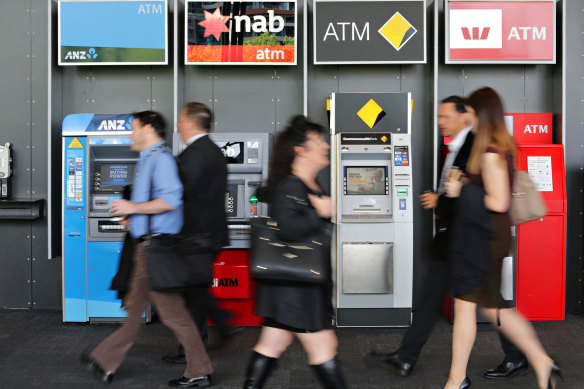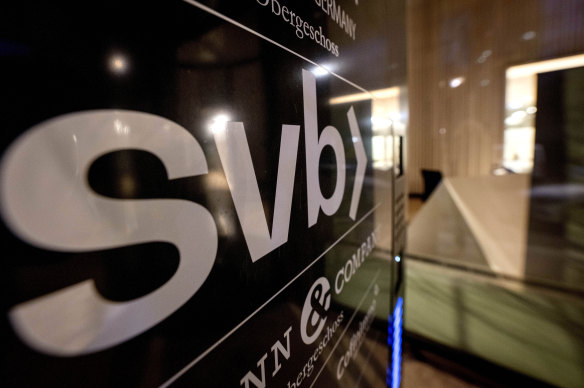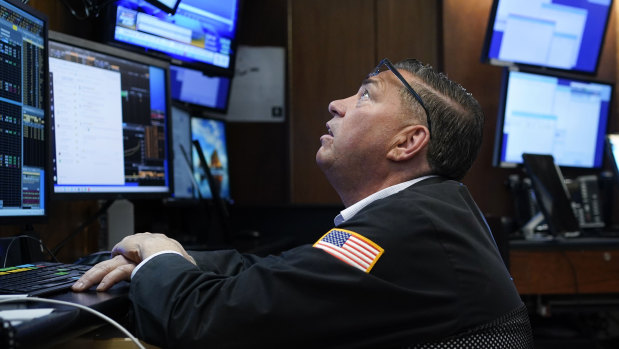ASX down 0.6 per cent as banks, tech stocks sink
By Emma Koehn
Australia’s most valuable banking, tech and consumer stocks dragged the local sharemarket 0.6 per cent lower in the first hours of Monday’s trading as investors digested the implications of Silicon Valley Bank’s collapse despite assurances from US regulators that they would protect depositors.
The S&P/ASX 200 was 40.1 points, or 0.6 per cent, lower to 7104.6 at midday, having opened 0.3 per cent weaker.
Local banking stocks started the day in the green but the financials sector was 1.2 per cent lower at noon, with all four big banks posting losses.

Tech stocks were damaged the most, with the sector declining 1.9 per cent. Accounting platform Xero lost 2.3 per cent to $84.76 by 11.45am, despite having no exposure to SVB.
In a statement on Sunday evening Washington time, Treasury Secretary Janet Yellen and Federal Reserve chair Jerome Powell confirmed the Federal Deposit Insurance Corporation (FDIC) had been instructed to guarantee deposits for Silicon Valley Bank customers, who would have access to their money from Monday US time.
These assurances were not enough to steady the market as investors digested the causes and broader flow-on of SVB’s demise.
CSL shares were 0.8 per cent lower to $283.69, retail conglomerate Wesfarmers was 1.1 per cent down to $49.37 and grocery giant Woolworths group slipped 0.5 per cent.
Australian companies across the technology sector rushed to update the ASX before the market open on Monday about whether they had exposure to SVB.
Nitro Software confirmed it had $US12.8 million ($19.3 million) in cash deposits with the bank, while location-based services company Life360 had a $6.1 million exposure. Nitro shares were 0.5 per cent stronger at midday, while Life360 was 0.4 per cent weaker.
SiteMinder, Sezzle, Redbubble and Ike GPS also revealed they had small exposures, while accounting software operator Xero said it had no material exposure to the business.
Investors got a clearer picture of how exposed Australian companies were to the US bank throughout the morning as venture capital firms started to comment on how their portfolio companies were affected.
In a statement, AirTree ventures said that while the fund had no exposure to SVB directly, 28 per cent of the companies that it invested in had an account with the bank.
The collapse has left economists and analysts trying to work out whether Silicon Valley Bank’s fate is an isolated incident, or a canary in the coal mine that points to vulnerabilities in the financial system brought about by the last year of interest rate rises.
Betashares economist David Bassanese said on Monday morning that no matter what happened next with SVB, the situation was unlikely to be resolved quickly and might even be enough for the Federal Reserve to pause interest rate rises next month.
“Depending on the fallout in the next few days, moreover, the mayhem will likely be enough to encourage the RBA to pause at the April meeting also,” he said.
Higher rates tend to hit hardest on investments seen as the riskiest and most expensive, such as cryptocurrencies and Silicon Valley start-ups.

“There are starting to be cracks that are appearing,” said Brent Schutte, chief investment officer at Northwestern Mutual Wealth. “SVB is a warning for the Fed that their actions are beginning to have an impact.”
The Fed has already raised rates at the fastest pace in decades and made other moves to reverse its tremendous support for the economy during the pandemic. It’s effectively pulling money out of the economy, which can tighten the screws on the system.
“This is a warning sign that the liquidity is draining, and the most vulnerable areas are starting to show it, which tells me the rest of the economy is not too far behind,” Schutte said.
Wall Street already in February gave up on hopes that cuts to interest rates could come later this year. Worries then flared this week that rates are set to go even higher than expected after the Fed said it could re-accelerate the size of its rate rises.
Friday’s jobs report helped calm some of those worries, which led to some up-and-down trading. Overall hiring was hotter than expected, which could be a sign the labour market remains too strong for the Fed’s liking.
But the data also showed a slowdown from January’s jaw-dropping hiring rate. More importantly for markets, average hourly earnings for workers rose by less in February than economists expected.
That’s crucial for Wall Street because the Fed is focusing on wage growth in particular in its fight against inflation. It worries that too-high gains could cause a vicious cycle that worsens inflation, even though raises help workers struggling to keep up with rising prices at the register.

Among other signs of a cooling but still-resilient labour market, the unemployment rate crept up. and the percentage of Americans with or looking for jobs edged higher.
Such trends mean traders are pulling back on bets the Fed will return to a rise of 0.50 percentage points later this month. They’re now largely betting on the Fed sticking with a more modest 0.25 percentage point rise, according to CME Group.
Last month, the Fed slowed to that pace after earlier rising by 0.5 and 0.75 percentage points.
Such expectations, along with worries about banks, helped send Treasury yields sharply lower.
The yield on the 10-year Treasury bond plunged to 3.69 per cent from 3.91 per cent late on Thursday, a sharp move for the bond market. It helps set rates for mortgages and other important loans.
with AP
The Market Recap newsletter is a wrap of the day’s trading. Get it each weekday afternoon.
Most Viewed in Business
Source: Thanks smh.com